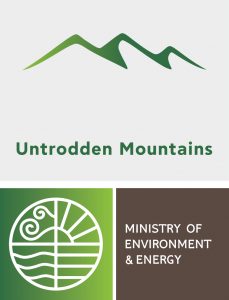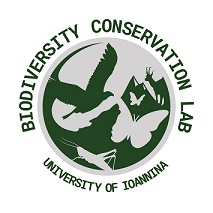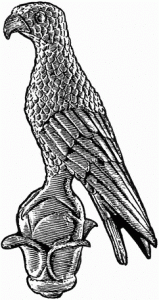ROADLESS
Project info
Assoc. Prof. Vassiliki Kati, scientific coordinator
Antonia Galani, project coordinator
Dr. Christina Kassara, biologist
Dr. Haritakis Papaioannou, biologist
Dr. Olga Tzortzakaki, biologist
Maria Psaralexi, biologist, PhD student (AUTH)
Maria Petridou, agronomist, PhD student (BCL/UOI)
Monika Hoffmann, forester, PhD student, Polish Academy of Sciences
Prof. Vassiliki Kati, scientific coordinator
Antonia Galani, biologist
Dr. Christina Kassara, biologist
Dr. Haritakis Papaioannou, biologist
Dr. Olga Tzortzakaki, biologist
Maria Psaralexi, biologist, PhD student (AUTH)
Maria Petridou, agronomist, PhD student (BCL/UOI)
Dimitris Gotsis, Engineer
Stratos Papantoniou, MSc student (BCL)
Goal
Research questions
- How serious is the problem of landscape fragmentation in Greece?
- Are any roadless areas remaining in Greece as high natural value landscapes and where?
- How much has the Nature 2000 network contributed to halting nature fragmentation?
- What are the effects of roads on Balkan chamois population in Mount Tymfi?
- What is the opinion of Greek society about roads?
- How roadless areas can be integrated into the European and national environmental policy?
-
How could natural undisturbed areas be expanded and connected?
Why such research?
It is not by coincidence that the biodiversity crisis era happens at the same time with the most explosive road sprawl in human history. With the length of paved roads projected to increase at a magnitude of 60% by 2050, road sprawl is a key driver triggering or accelerating land use change, which is recognized to be the top threat for biodiversity decline globally and in the EU. On one hand, road infrastructure is known to promote economic growth and human welfare, but on the other hand it causes land use change, fragmentation, increase of artificial land, chemical pollution, hydrological disruption, soil erosion, acceleration of biological invasions, animal mortality, overexploitation of natural resources and other often irreversible negative impacts to wildlife and ecosystem functioning. Humanity is dependent on biodiversity and ecosystem services and hence threatened by their collapse. The conservation of roadless areas (RAs) is recognized as a cost-effective and efficient tool to preserve biodiversity and its benefits for humans.
According to a recent report of the European Environmental Agency, Greece is less fragmented than the rest of Europe but presents higher rates of fragmentation increase. We evaluate the fragmentation intensity of Greece in terms of RAs number and extend. RAs are those land patches over 1 km2 that are at least 1 km away from the nearest road. We work in the science-policy interface suggesting the legal conservation of large RAs and roadless islands are wilderness areas of high ecological, natural and aesthetic value that they should be preserved from degradation and fragmentation.
Actions
BCL has undertook two projects (ROADLESS, NATLAND) to deliver the national roadless map of Greece, update the SEBI 13 European indicator, and provide scientific evidence and guidelines for incorporating roadless areas in national environmental policy and planning.
ROADLESS project activities:
- Road mapping and delineation of extended RAs (over 50 km2) using GIS
- Spatial data analysis of roadless areas polygons vs the Natura 2000 network
- Ecological modeling to assess the contribution RAs to the conservation of wild fauna, taking as a case study the Balkan chamois (Rupicapra rupicapra balcanica) population in Tymfi mountain (species protected by the Habitats Directive 92/43/EC)
- Synthesis of results in a final report on the use of extended RAs in the national environmental planning
- Public awareness and result dissemination activities to the scientific community (databases, papers) and to policy makers and society (website, popular science, online questionnaire, policy brief, video spot)
NATLAND project activities:
- Road mapping and delineation of all roadless areas in Greece above 1 km2
- Identification of roadless islands of any size
- Update of the European Indicator SEBI 13 for Greece “Fragmentation of natural and semi-natural ecosystems”, and of the relevant chapter in the national environmental state outlook
- Synthesis of research outputs in a final report on the use of undisturbed natural areas (roadless areas and their buffer zone of 1km) in national environmental policy and planning
- Public awareness and result dissemination activities to policy makers and society (website, popular science, policy brief, webinars)
The interactive national roadless map of Greece
Click here to open the interactive map of Roadless Areas of Greece.
Results
Databases
Kassara C., Petridou M., Tzortzakaki O., Papantoniou E., Galani A., Psaralexi M., Gkotsis D., Papaioannou H., Kati V. 2022. The roadless map of Greece. Mendeley Data, v2.
Kati V, Kassara C, Psaralexi M, Tzortzakaki O, Petridou M, Galani A, Hoffmann M. 2020. The roadless map of Greece. Mendeley Data, v1.
Publications
Kati, V., Kassara, Ch., Vassilakis, D., Papaioannou, H. 2020. Balkan Chamois (Rupicapra rupicapra balcanica) Avoids Roads, Settlements, and Hunting Grounds: An Ecological Overview from Timfi Mountain, Greece. Diversity, 12 (4), pp 124.
Kati V, Kassara C, Psaralexi M, Tzortzakaki O, Petridou M, Galani A, Hoffmann MT. 2020. Conservation policy under a roadless perspective: Minimizing fragmentation in Greece. Biological Conservation 252:108828.
Kati, V., Selva, N., Sjögren-Gulve, P., 2022. Greek roadless policy: A model for Europe. Science 375 984.
Kati, V., Petridou, M., Tzortzakaki, O., Papantoniou, E., Galani, A., Psaralexi, M., Gotsis, D., Papaioannou, H., Kassara, C. 2023. How much wilderness is left? A roadless approach under the Global and the European Biodiversity Strategy focusing on Greece. Biological Conservation 281, 110015.
Kati, V*., Kassara, C*., Panagos, P., Tampouratzi, L., Gotsis, D., Tzortzakaki, O., Petridou, M., Psaralexi, M., Sidiropoulos, L., Vasilakis, D., Zakkak, S., Galani, A., Mpoukas, N., 2023. The overlooked threat of land take from wind energy infrastructures: Quantification, drivers and policy gaps. Journal of Environmental Management 348, 119340.
Policy Brief
Open lectures

Kati V. 2021. The nexus roads-windfarms-biodiversity under the light of sustainable spatial planning. University of Thessaly – Department of Civil Engineer. 22/12/2021. (in Greek)

Kati V. 2021. The triptych biodiversity-roads-windfarms in the context of the Sustainable Development Goals: the Greek case. Open University of Cyprus.10/2/2021. (in Greek)

Kati V. 2021.. Need of habitat fragmentation minimization policy in the EU for resolving road sprawl -wind farm -biodiversity loss nexus: the case of Greece. Policy Committee of the European Section of the Society for Conservation Biology. 26/1/2021. (in English)
Conferences

Κατή Β., Πετρίδου Μ., Τζωρτζακάκη Ο., Παπαντωνίου Ε., Γαλάνη Α., Ψαραλέξη Μ., Γκότσης Δ., Παπαϊωάννου Χ. & Χ. Κασσάρα. 2023. Οι περιοχές χωρίς δρόμους της Ελλάδας ως προτεραιότητα για την προστασία της άγριας φύσης και του τοπίου: σύνδεση με το δίκτυο Natura 2000 και το χωροταξικό σχεδιασμό. 11ο Πανελλήνιο Συνέδριο Οικολογίας. Πάτρα, 4-7 Οκτωβρίου 2023.

Kati. V., Kassara, C., Tzortzakaki. O. , Petridou, M., Psaralexi, M., Galani, A., Gotsis, D., Papantoniou, S., Papaioannou, H. 2022. Greece shows the way for a roadless policy in Europe: links with the European biodiversity strategy. 6th European Congress of Conservation Biology (ECCB) “Biodiversity crisis in a changing world”. Czech University of Life Sciences, Prague, Czech Republic. 22-26 August.

Kati, V., Kassara, Ch., Vasilakis, D.P., Papaioannou, H. 2021. The anthropogenic risk avoidance hypothesis applies to the Balkan Chamois (Rupicapra rupicapra balcanica): an ecological overview from a Natura 2000 site in Greece

Kati V. 2021. Need of habitat fragmentation minimization policy in the EU for resolving road sprawl -wind farm -biodiversity loss nexus: the case of Greece. Policy Committee of the European Section of the Society for Conservation Biology. 26/1/2021. Webinar.
New Roadless Legislation
In this section we provide: (a) an overview of the roadlessness legislation, where you can find the rationale of the new legislation, as communicated by the Greek Ministry of Environment and Energy in January 2022, in the frame of the project untrodden mountains, (b) the content of the legislation, describing the articles of the six Ministerial Decisions in English, and (c) the Ministerial Decisions (in Greek) followed by their respective maps (kmz files).
Roadlessness legislation overview
The following information notice was published from the press office of the Hellenic Ministry of Environment and Energy
Tuesday, 18 January 2022
Information Note
How are “Untrodden Mountains” defined?
“Untrodden Mountains” are defined as Roadless Areas (RAs) surrounded by a buffer zone of one kilometer (RAs+ radius 1 km). In these areas new roads and other artificial interventions, which alter or degrade the natural environment, are prohibited. In addition, they are subject to a strict protection regime.
Which areas will be included in the Untrodden Mountains?
- Lefka Ori – Area: 382.06 sq.km. | Altitude: 0-2.453 m.
- Saos – Area: 97.30 sq.km. | Altitude: 0-1.611 m.
- Smolikas – Area: 102.89 sq.km. | Altitude: 782-2.637 m.
- Tymfi – Area: 202.75 sq.km. | Altitude: 460-2.497 m.
- Taygetos – Area: 143.23 sq.km. | Altitude: 432-2.407 m.
- Hatzi – Area: 45.61 sq.km. | Altitude: 598-2.038 m.
How did we institutionalize Roadless Areas?
By Ministerial Decision, authorizing article 47 of law 4685/2020, per region:
- Formal ban of the construction of roads accessible by motor vehicles, the extension of the existing ones regardless of category, as well as any kind of technical intervention, alteration, or deterioration of the natural environment.
- Legally existing projects and their maintenance are not affected.
- Marking, repairing, maintaining, and improving existing mountaineering and hiking trails is allowed, without the use of motorized means of access and provided that the interventions will be implemented with natural materials.
- Projects for the purposes of National Defense, as defined in accordance with the provisions of current legislation, are excluded from the terms and restrictions.
- Projects and interventions that are implemented due to emergencies (earthquakes, floods, disasters, fires, etc.) are excluded from the above prohibitions, if care is taken afterwards for the restoration of the environment, as well as projects and interventions that are deemed necessary for reasons of protection and or restoration of the natural and forest environment.
Is this initiative blocking investments?
“Untrodden Mountains” are a brake on the overexploitation of the environment by human activities, but without putting obstacles in investments, as they concern areas untouched over time.
Ecotourism can be developed in any area that is interesting in terms of biodiversity and landscape aesthetics, contributing to the maintenance or creation of incentives for the transition to green economic activity such as organic farming, promotion of traditional products, etc.
What are the benefits of “Untrodden Mountains”?
- They contribute to the conservation of biodiversity.
- They prevent the entry of invasive alien species.
- They provide migration routes and intermediate stopovers to fauna species.
- They capture carbon and reduce the effects of greenhouse gases.
- They maintain the connectivity and integrity of ecosystems.
- They offer recreation, education, and scientific knowledge to citizens.
- They regulate and maintain ecosystem services: clean water supply, erosion control, healthy soil, air quality, climate regulation, crop pollination, high resistance to parasite epidemics.
How do we define “land fragmentation” and what are the consequences of this phenomenon?
Land fragmentation is the segmentation of natural ecosystems into pieces by the increase of roads and artificial surfaces.
Fragmentation has direct consequences in:
- Loss, congregation, and isolation of the habitats of species
- Population declines and local extinctions of species
- Degradation of ecological processes
Greece’s fragmentation index is half than that of Europe, but it is growing faster. Specifically:
- Greece was ranked in the first place of artificial land increase in Europe (2015)
- Construction sites and roads consume more land in Greece than in Europe.
- The road network of Greece has a length of more than 367,000 km, while the probability of being at a distance greater than one kilometer from any road is only 5.43%.
What is the relationship of roads with biodiversity loss?
Roads facilitate the transport of people and goods and are directly linked to enhancing economic development locally and nationally.
Despite the significant benefits of having a useful road network, roads are related to the top five causes of biodiversity loss worldwide, which are in descending order of severity:
- Land use change
- Direct natural resources exploitation
- Climate change
- Pollution
- Invasive species
Roads are therefore considered to be one of the main causes of biodiversity loss and ecosystem degradation worldwide, especially when penetrating natural ecosystems and formerly undisturbed areas.
The habitats of species are shrinking, populations are isolated, wildlife mortality from vehicle collisions on the road network is increasing.
At the same time, all the ecosystem services associated with the soil, such as decomposition, or nitrogen cycle, are lost, as the soil is sealed and converted into artificial land.
Human health is indirectly affected through the increase of pollution and the facilitation of the spread of diseases.
Why are “Roadless Areas” a matter of global interest?
We live in an unprecedented time of biodiversity crisis. The sixth mass extinction of species in Earth history, attributed to anthropogenic causes, has begun, and at least 70% of the earth has been degraded, posing a serious threat to human well-being.
At the same time, we live in a time of culmination of the expansion of artificial surfaces and especially of roads.
The length of the new paved roads is expected to increase by 59% by 2050.
Top scientists consider road construction as the worst threat to the planet for the loss of biodiversity, and therefore the preservation of Roadless Areas as the key policy to halt the loss of biodiversity.
This new trend of conservation of Roadless Areas has now been embraced by global societies (SCB, IUCN, UNEP, Conservation International, Tebtebba) and the issue has taken global dimensions at the United Nations Summit on the Convention on Biological Diversity (COP 11, India. and in Rio + 20, Brazil, 2012).
Is there a statute of “Untrodden Mountains” in the EU?
Greece becomes the first country in Europe to institutionalize “Untrodden Mountains”.
The issue of natural land fragmentation was considered to be one of the greatest challenges in the EU in the vote of the European Parliament on 08/06/2021 for the new Biodiversity Strategy 2030, entitled “Return of Nature to our lives”, which took place in early June. Besides, the obligation to assign a strict protection regime to at least 10% of the territory of each country was voted.
The European Commission has put forward a proposal for legally binding EU restoration targets in 2021. The restoration of EU ecosystems will contribute to enhance biodiversity, mitigate and adapt to climate change and prevent and reduce the effects of natural disasters.
The main objective of the EU initiative is to restore degraded ecosystems, especially those with the greatest potential:
- Carbon capture and storage.
- Prevention and reduction of the effects of natural disasters.
- Soil health and pollination.
- Improving the knowledge and monitoring of ecosystems and their services.
With the institutionalization of the Untrodden Mountains, we proactively follow this restoration policy.
“Roadless Areas” conservation first began in 2001 in the United States under the title “The Roadless Rule” and is currently being studied by the European Union to be integrated into the objectives of the Green Agreement.
With what goals are “Roadless Areas” harmonized?
Roadless Areas contribute to the achievement of 12 objectives of the National Biodiversity Strategy such as:
- Preservation of the national physical capital (objective 2.1).
- Delineation of ecological corridors (objective 3.3).
- Enhancement of the synergy of key sectoral policies by conserving biodiversity and establishing incentives (targets 5.1-5.8).
- Conservation of landscape diversity (objective 6.2).
- Dealing with invasive alien species (objective 8.2).
Furthermore, based on the recent United Nations National Assessment Report on the Sustainable Development Goals, eight national priorities were set by the General Secretariat of the Government for Agenda 2030.
The designation of the extended RAs and their introduction in the spatial planning of the country, is documented as a positive contribution to the achievement of three Sustainable Development Goals:
- Responsible consumption and production (goal 12).
- Climate action (goal 13).
- Life on land (goal 15)
In the context of the 6th national priority under the title: “Strengthening the protection and sustainable management of natural capital as a basis for social prosperity and the transition to a low carbon economy”
Finally, Roadless Areas are in line with the European Landscape Convention, as ratified by Greece, according to which the landscape is “a key component of the European natural and cultural heritage”.
FROM THE PRESS OFFICE
Content of roadlessness legislation
Each Ministerial Decision is structured as follows:
Title
Terms and restrictions for the roadless area of the mountain [..name of the mountain]
The vice minister of Environment and Energy takes into consideration… a list of legal and other official documents is inventoried, referring also to our Roadless project as well as to the suggestions from the General Directorate of Environmental Policy of the Ministry of Environment and Energy (attached document in Ministerial Decisions section).
Article 1: Goal
The first article of all Ministerial Decisions presents the goal of the legislation, as follows:
“The purpose of the present is the effective protection of the habitat types and the flora, wild fauna and bird species and their habitats of the roadless area [name of the roadless area] through the institutionalization of special conditions and restrictions.
In particular, the following is sought:
(a) halting land-use change, which is the leading cause of biodiversity loss at global and European level;
(b) halting the expansion of artificial land and the fragmentation of natural ecosystems by roads and artificial surfaces, and their associated negative impacts on biodiversity;
(c) the conservation of the habitat types and the species of flora, wild fauna and avifauna occurring in the area;
(d) the preservation of the natural, cultural, historical, aesthetic and other values of the landscape as defined in the European Convention on Landscape;
(e) the preservation of mild traditional anthropogenic activities which do not disturb natural ecosystems and their natural evolution;
(f) the development of nature-loving, trekking, mountaineering, and ecological tourism in areas of high natural and aesthetic value compatible with the above individual objectives; and
(g) the institutionalization of conditions and restrictions to ensure the harmonious coexistence of man and nature in the context of mild and sustainable development.”
Article 2: Designation of the area that the decision applies
In the second article, the boundary of the roadless area is presented, followed by a map in Appendix 1, and by a table with the exact coordinates (Greek Grid) in Appendix 2, its area in square kilometers, and its elevation range (meters). The sites of the Natura 2000 network with their codes that overlap with the roadless area are also presented. The last paragraph stresses the importance of the area as an undisturbed natural area without roads accessible by motorized vehicles and other artificial surfaces.
Article 3: Terms and restrictions
The third article presents the restrictions and conditions in the roadless area defined in article 2 as follows:
“In the whole area of Article 2:
(1) It is prohibited the construction of roads accessible by motor vehicles, regardless of category, and any kind of technical intervention, alteration or deterioration of the natural environment.
(2) From the present, legally existing projects and their maintenance are not affected.
(3) In particular, marking, repairing, maintaining and improving existing mountaineering and hiking trails is allowed, without the use of motorized means of access and provided that the interventions will be implemented with natural materials.
(4) Projects for the purposes of National Defense, as determined in accordance with the provisions of current legislation, are exempted from the terms and restrictions of this.
(5) Exempted from the above prohibitions:
(a) projects and interventions implemented due to emergencies (earthquakes, floods, natural disasters, fires, etc.) if care is taken afterward to restore the environment.
(b) projects and interventions deemed necessary for reasons of protection and/or restoration of the natural and forest environment.”
Article 4: Control-Penalties
The article presents shortly the implementation of the Ministerial Decision as follows:
(1) The control of compliance with the provisions of this and the confirmation of any infringements for enforcement sanctions shall be made by the competent authorities on the basis of current legislation.
(2) The guarding and supervision of the area are implemented by the competent bodies.
Article 5
The article quotes “The validity of this decision starts from its publication and lasts for two (2) years.”
Appendices
The legislation includes Appendix 1 ( map of the roadless area) and Appendix 2 (coordinates of the roadless area)
Ministerial Decisions on roadless areas of Greece
For each roadless area, you can download: (a) the official ministerial decision as published in the governmental journal (FEK), (b) the suggestion signed from the General Directorate of Environmental Policy of the Ministry of Environment and Energy, and (c) the map of the roadless area as a kmz file (Google Earth). All such files are available to download in this google drive “FEK_6_Roadless Areas” [It is dynamically updated with new legislation when published].
Media
This section lists articles of the international or national/ local press referring to the scientific findings of our research. The articles are indicative and are quoted without necessarily reflecting the opinion of BCL. The media coverage of our research is an indicator of the impact of our research on society.
INTERNATIONAL PRESS
10/2/2022: DNR- Dachverband der deutschen Natur-, Tier- und Umweltschutzorganisationen. Mit gutem Beispiel voran: Griechenland beschließt “straßenlose Zone” [German]
28/1/2022: Paweł Wernicki. Nauka W Polsce. Grecja chroni swoje bezdroża [Polish]
NATIONAL PRESS
24/2/2022. Τ. ΣΑΡΑΝΤΗΣ. Η εφημερίδα των Συντακτών. “Απάτητα Βουνά” μόλις το 1% των ορεινών εκτάσεων.
6/2/2022. Η εποχή. Έξι απάτητα βουνά, τα άλλα καταπατημένα
21/1/2022. CNN Greece. «Απάτητα Βουνά»: Σύσκεψη υπό τον Μητσοτάκη για την περιβαλλοντική θωράκισή τους
21/1/2022. Ελεύθερος Τύπος. Μητσοτάκης: Εξι «Απάτητα Βουνά» χωρίς ανεμογεννήτριες – Η άλλη όψη του αναπτυξιακού μας προγράμματος
21/1/2022. Έθνος. Έξι βουνά της χώρας σε καθεστώς πολύ αυξημένης περιβαλλοντικής θωράκισης – Τι είπε ο Κυριάκος Μητσοτάκης
21/1/2022. Καθημερινή. «Απάτητα βουνά»: Παρουσιάστηκε το σχέδιο.
21/1/2022. Πρώτο ΘΕΜΑ. Μητσοτάκης για «Απάτητα Βουνά»: Μπαίνουν σε καθεστώς αυξημένης περιβαλλοντικής θωράκισης
21/1/2022. Το Βήμα. Μητσοτάκης: Το project «απάτητα βουνά» είναι η άλλη όψη του αναπτυξιακού μας προγράμματος
20/1/2022. Β. ΕΥΘΥΜΙΟΠΟΥΛΟΥ. Liberal. Μια πρωτοβουλία μοναδικής σημασίας
20/1/2022. Ριζοσπάτης. Προσπάθεια απόκρυψης της ληστρικής εκμετάλλευσης και καταστροφής των ορεινών όγκων
19/1/2022. CAPITAL. Για ποια αιολικά πρότζεκτ θα παραμείνουν “απάτητα τα βουνά”
19/1/2022. Α. ΧΑΤΖΗΓΕΩΡΓΙΟΥ. Η εφημερίδα των Συντακτών. Τα απάτητα βουνά και η περιφέρεια του Κ. Σκρέκα
19/1/2022. Ναυτεμπορική. «Απάτητα» 6 βουνά της χώρας: Ποια project ανανεώσιμων πηγών παγώνουν
19/1/2022. Καθημερινή. Ποια είναι τα ελληνικά «Απάτητα Βουνά»
19/1/2022. ΤΑ ΝΕΑ. Το νέο καθεστώς για έξι βουνά
16/12/2021. Energia.gr. Γιώργος Αμυράς στην Βουλή για “Απάτητα Βουνά” και Προστατευόμενες Περιοχές Νatura
24/11/2021: Γ. ΛΙΑΛΙΟΣ. Καθημερινή. “Απάτητα βουνά μακριά από δρόμους και τσιμέντο. Ο Γ. Αμυράς μιλάει στην Κ
22/12/2020: Γ. ΛΙΑΛΙΟΣ. Καθημερινή. «Οι πολλοί δρόμοι βλάπτουν τη φύση»
1/11/2021. Ομιλία του Πρωθυπουργού Κυριάκου Μητσοτάκη στη διάσκεψη των Ηνωμένων Εθνών για την κλιματική αλλαγή COP26 (Ανακοίνωση των Απάτητων Βουνών). Primeminister.gr
LOCAL PRESS
6/2/2022. Ελευθερία [Λάρισα]. Έτσι θα μείνει ανέγγιχτος ο φυσικός πλούτος της Ελλάδας
6/2/2022. Ρέθεμνος. [Κρήτη]. Αγία Ρουμέλη: Γιατί ζητά να εξαιρεθεί από τον θεσμό «Απάτητα Βουνά»
4/2/2022: Ευρυτανικός παλμός. [Ευρυτανία]. Θα γίνουν… ‘Απάτητα’ τα βουνά της Ευρυτανίας;
4/2/2022. Χ. ΜΕΓΑΣ. Μαχητής. [Άρτα]. Τα απάτητα και τα «σπαρμένα» με… ικριώματα βουνά μας
3/2/2022. The Best [Πάτρα]. Τα έξι “απάτητα” βουνά της Ελλάδας σε καθεστώς προστασίας
28/1/2022. Γ. ΧΑΛΑΤΣΗ. Ηπειρωτικός Αγών. [Ιωάννινα]. Άλλοθι για την αντιπεριβαλλοντική πολιτική τα «Απάτητα Βουνά»
19/1/2022. TheNewspaper.gr. Ποια είναι τα ελληνικά «Απάτητα Βουνά» – Φρένο σε επενδύσεις ΑΠΕ
22/1/2022 .Epiruspost.gr. [Ήπειρος] «Απάτητα Βουνά» με βάση την μελέτη της Κικής Κατή
19/12/2021. Β. ΑΓΓΕΛΗ. typos-i. [Ιωάννινα]. Στα «Απάτητα Βουνά» της Τύμφης και του Σμόλικα (κι όχι μόνο)
25/12/2020: Ρέθεμνος. [Κρήτη] «Απειλή για το περιβάλλον η διάνοιξη δρόμων στα Λευκά Όρη»
24/12/2020: Ηπειρωτικός Αγών. [Ιωάννινα] «Αντιστέκονται Τύμφη και Σμόλικας στην κατάτμηση από δρόμους»
23/12/2020. Epirustvnews. [Ήπειρος] «Κ.Αρσένης: Υπό Εξέταση Η Προστασία 6 Βουνών Της Ελλάδας Από Άναρχα Αιολικά Λόγω Της Σημασίας Τους Για Την Βιοποικιλότητα»
INTERVIEWS & ARTICLES BY BCL
21/2/2022. Β. ΚΑΤΗ. Η εφημερίδα των Συντακτών. Διάλογος για τα Απάτητα Βουνά. [Το άρθρο συνιστά απάντηση σε τοποθέτηση του κ. Γ. ΜΠΑΛΙΑ από 13/2/2022 με τίτλο: Τα “Απάτητα Βουνά” και οι ταπεινωμένες κορυφές. Ένθετο Νησίδες της εφημερίδας των Συντακτών]
12/2/2022. BCL dasarxeio.com Απάτητα Βουνά: Διαφάνεια και διάχυση της επιστημονικής γνώσης.
6/2/2022. Θ. ΑΡΑΜΠΑΤΖΗΣ. Ελευθερία [Λάρισα]. Έτσι θα μείνει ανέγγιχτος ο φυσικός πλούτος της Ελλάδας [Συνέντευξη Β. Κατή/ BCL]
3/2/2022. Γ. ΓΚΟΝΤΖΟΣ. Δημοτικό ραδιόφωνο Ιωαννίνων. Συνέντευξη για τις Περιοχές Άνευ Δρόμων. [ηχητικό αρχείο]
20/1/2022. E. ΚΩΝΣΤΑΝΤΙΝΙΔΟΥ. Εκπομπή Ο3 -ΕΡΤ. Τα έξι “απάτητα βουνά” της Ελλάδας σε καθεστώς προστασίας. [Συνέντευξη Χ. Κασσάρα/BCL (you tube)].
17/3/2021. Πράσινες Ιστορίες – ΕΡΤ. Περιοχές Άνευ Δρόμων. Ντοκυμαντέρ με συνέντευξη της Β. Κατή. Σκηνοθεσία Β. Ευθυμίου. [βίντεο ertflix].
Το χρονικό των "Απάτητων Βουνών"
Impact of roadless legislation
Short review of the feedback of stakeholders on the Greek roadless areas legislation, including scientific societies, and NGOs.
International networks
SCB Europe Press Release: Greece gives legal protection to roadless areas. 27/1/2022. See here και here
SCB Europe letter to the European Commission on roadless policy and fast renewable infrastructure development. 26/3/2021. See here
NEMOR letter to the European Commission on “Need for European mountainous landscapes conservation through a roadless policy”. 12/7/2022. See here
WILD EUROPE: Greece leads the way to roadless protection. See here
National announcements (in Greek)
26/1/2022: Hellenic Ecological Society. Announcement
27/1/2022. Hellenic Zoological Society. Announcement.
9/2/2022. Hellenic Ornithological Society. Announcement
9/2/2022. Announcement of 11 Greek NGOS: ΑΝΙΜΑ, Arcturos, Elliniki Etairia-Society for the Environment and Cultura Heritage, Hellenic Society for the Protection of Nature, Callisto, Ecological Recycling Society, Greenpeace, MEDASSET, Mom, WWF
News
News on the ROADLESS & NATLAND projects, including notifications of new material published, articles in the press and other media, relevant policy impact and feedback from society are posted in the BCL facebook page. Selected news are posted here





